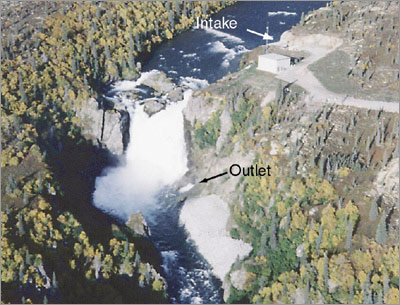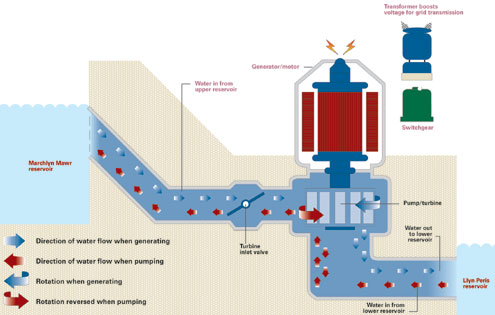Hydropower
Overview
As we begin to realize the impacts of global warming, we must prepare for the future, in terms of our own survival and the survival of our environment. Nix the first sentenceApproximately 7% of energy used in the United States is renewable. Of the 7% of renewable energy used, only about 36% of it was produced by hydropower. The amount used may vary from year to year due to the amount of precipitation, and the geographical area.I'd nix that sentence, too. It's very general. About 8% of renewable sources produced electricity in 2007. 71% of the renewable electricity was created by hydropower. [1] Hydropower is one of the most environmentally friendly ways to produce energy. This procedure to produce energy does not negatively impact the air, nor the water. Hydropower is a step that can be taken into consideration for the transit into the clean energy future we all hoped for. Reread the last 3 sentences for clarity. You might just want to say: Hydropower is an efficient, clean energy source. Using hydropower rather than fossil fuels will alleviate the effects of climate change in the future.
If hydropower was eliminated on a global scale, replacing the energy production with thermal resources - an additional 1112 million tons of coal, 4449 million barrels of oil, or 26,696 billion feet cubed of natural gases will be added to the existing usage Reread sentence for clarity.. [2]
Hydropower is energy created by capturing the kinetic energy of channeling and harnessing water. The amount of energy created is determined by the flow and/or the fall of moving water. Energy is created through a simple process in which the water flows through pipes, which then pushes against turbines to spin generators in which electricity is produced. Dams are storage systems for this method of creating energy. By having the power to control the water movement, water can be released when there is a high demand for electricity. The dams helps with irrigation but create some discrepancies for natural habitat like fishes. discrepancies isn't the right word. do you mean that dams help irrigate land but might cause other problems, such as changing the natural habitat of fish?
Types of Hydropower Plants
Micro Hydropower
Small Hydropower
Large Hydrpower
Impoundment
Impoundment is the most common type of hydroelectric power plants. This system of a larger hydropower plant requires a dam to store a river in a reservoir. Water is controlled and released to meet the electricity needs or to maintain reservoir levels. Electricity is produced when water is released, allowing water to flow through a turbine, which then spins the turbine, activating a generator that produced the electricity needed. [3] 
Diversion
Diversion is another also known as "run-of-water". It may or may not require a dam in the process of producing electricity, but it channels river through a canal or penstock. [4] 
Pumped Storage
During a period when demand of electricity is high, water is released into the lower reservoir to generate electricity. When the demands for electricity is low, the pumped storage facility stores the energy by pumping water from a lower reservoir to an upper reservoir. [5] 
Different Forms of Hydropower
Tidal Power
Wave Power
Water Wheel Good photos and brief explanations above, but I assume you're going to fill in with more writing?
Costs
Many people are discouraged by the initial cost to build plants for renewable energy. It is expensive and very capital intensive. Renewable energy plants are more expensive to build and operate than natural gas and coal plants. Hydropower plants are usually located in rural areas were there are flowing rivers and falls. The power is easily available in these remote areas. When it comes to the populated cities, transportation of the renewable Hydropower electricity is more difficult. Transmission lines are required to deliver the power necessary. The investment is very useful in the long run. Generating and producing the power from Hydropower is very cheap. [6]
United States new Policy to Encourage Renewable Energy
In recent years, the U.S. government began giving tax incentives for renewable energy. The Renewable Electricity Production Tax credit was also introduced to encourage an increase in renewable energy. Each State of the United states now has a Renewable Portfolio Standards (RPS) in which each states require their energy providers to generate or acquire a certain percentage of generation from renewable energy. The Renewable Energy Certificate/credit (REC) is built into the RPS system. This allows the electricity providers of each state to sell renewable energy certificates/credit. With the proceeds, new investments in renewable energy projects can be made. [7]
Risk Analysis
There are some risks involved with developing hydropower plants. Due to the effects of global warming, some weather patterns are already beginning to alter. The change in precipitation pattern posses a great threat to any projects. Decreased stream and river flows can threaten energy resources. Not only will hydropower be effected, but also in nuclear energy production. Some areas of the world may gain an increase in annual rainfall, while other regions may experience a decrease in precipitation. The effects of altered precipitation include a diminished water supply, decrease in water quality, and greater flood risk as well as droughts. Society is hesitant in building newer hydropower plants because of the environmental threats, as well as the climate change itself shifting with precipitation patters. [8] The creation of electricity through hydropower is cheap. But if water becomes scarce in areas were they once flourished, then the prices might drastically increase. Currently, the world's population is exponentially growing. The water demand to supply water for everyone will also increase as population grows, even though the availability of clean water will become scarce. Hydropower projects have a negative impact on the river ecosystem This is a key point. Expand.
Notes
- ↑ Energy Information Administration. Dept. of Energy. 25 Oct. 2008 <http://eia.doe.gov>.
- ↑ Frey, Gary W., and Deborah M. Linke. "Energy Policy 30." Hydropower as a renewable and sustainable energy resource meeting global energy challangesin a reasonable way (2002): 1261-265.
- ↑ "Wind and Hydropower Technology Programs." Energy Effecientcy and Renewable Energy. 9 Aug. 2005. U.S. Department of Energy. 28 Oct. 2008 <http://www1.eere.energy.gov/windandhydro/hydro_plant_types.html>.
- ↑ "Wind and Hydropower Technology Programs." Energy Effecientcy and Renewable Energy. 9 Aug. 2005. U.S. Department of Energy. 28 Oct. 2008 <http://www1.eere.energy.gov/windandhydro/hydro_plant_types.html>.
- ↑ "Wind and Hydropower Technology Programs." Energy Effecientcy and Renewable Energy. 9 Aug. 2005. U.S. Department of Energy. 28 Oct. 2008 <http://www1.eere.energy.gov/windandhydro/hydro_plant_types.html>.
- ↑ Energy Information Administration. Dept. of Energy. 25 Oct. 2008 <http://eia.doe.gov>.
- ↑ Energy Information Administration. Dept. of Energy. 25 Oct. 2008 <http://eia.doe.gov>.
- ↑ Mann, Michael, and Lee R. Kump. Dire Predictions : Understanding Global Warming. Grand Rapids: Dorling Kindersley, Incorporated, 2008.